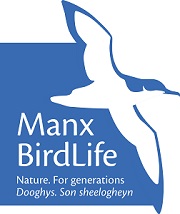A young White-tailed Eagle, named Aonghus, from County Galway in Ireland has taken up temporary residence on the Isle of Man.

Aonghus was born in the wild in Connemara, Co. Galway in the summer of 2018, and is part of the Irish White-tailed Eagle reintroduction project managed by The Golden Eagle Trust in collaboration with the National Parks & Wildlife Service.
Aonghus - a born traveller
Young White-tailed Eagles travel a great deal. Aonghus has proven to be no exception. First, he travelled from his birthplace on the west coast of Ireland to southwest Scotland. Aonghus then spent six months exploring northeast England. Now, he appears to be attempting the return journey to Ireland.
After his stay in northeast England, Aonghus moved back to Scotland, flying through Dumfries & Galloway to reach the port of Stranraer. On his original outward trip he had used the shortest sea crossing (21km) from Northern Ireland to the Mull of Kintyre. But the Stranraer (Mull of Galloway) crossing is 35km at its narrowest point.
For a while it seemed like Aonghus was either making his mind up or waiting for favourable winds, or perhaps simply ‘fuelling up’ on Loch Ryan near Stranraer. But rather than choosing to return across the sea back to Ireland from the Mull of Kintyre, he headed south to roost on cliffs on the southern tip of the Mull of Galloway, the arm that sticks out south towards the Isle of Man.
Aonghus’s next exciting move was to fly due south across the Irish Sea.
He was tracked by satellite arriving at the Calf of Man, before moving north up the west coast of the Isle of Man. Aonghus has now been reported by sharp-eyed observers in several areas of the Island, where he has been noted on the ground eating carrion.
Seeing Aonghus
Manx BirdLife is keen to receive reports of sightings of Aonghus, which will be shared with The Golden Eagle Trust.
While Aonghus is wearing a satellite tag - giving researchers regular information about his location and movements - firsthand observations of his presence and behavior are invaluable to the research team. As well as being distinctive due to his huge size, Aonghus is wearing a noticeable large green tag on his right wing and a large orange tag on his left wing.
It is important not to approach Aonghus. Manx BirdLife and The Golden Eagle Trust are urging members of the public not to attempt to get close for photographs, but to keep a distance of at least 300-400 metres away.
It is highly likely that Aonghus is fueling up for his final sea crossing as he heads back to his natal home in Ireland and he needs time and peace to go about his business.
It is especially important not to disturb Aonghus while he is feeding or resting on stone walls or in trees where he needs to quietly gather his energies and digest what he has eaten.
A note about Eagles and their prey
It takes a few years for young White-tailed Eagles to learn the skills of fishing – for which the species is famous. Adults and young are largely scavengers, eating a lot of carrion. Sheep carrion is often their main diet in the uplands in winter.
White-tailed Eagles are often seen around sheep carcasses, so it is easy to assume the eagle has killed the sheep. But this has not been a significant problem according to researchers who have extensively studied the species’ behavior.
Farmers have nothing to fear and the evidence reveals that the few incidents recorded have involved newborn/stillborn lambs. Indeed, the Eagle reintroduction project in Ireland has demonstrated over more than ten years that Eagles can and do exist alongside sheep farming and lambing without conflict.
White-tailed Eagles in the Isle of Man
Today, the White-tailed Eagle is at best an extremely rare vagrant to the Isle of Man.
The species is reputed to have nested on the Island’s coastal cliffs up to the nineteenth Century, although it was always a very rare bird on the Island. There have been no confirmed records of the species since 1950, though unsubstantiated reports have been received by Manx BirdLife from time to time.
It is to be hoped that the success of the Scotland, Ireland – and most recently, England – reintroduction programmes will see White-tailed Eagles re-establish themselves across much of their former range. The species was exterminated from the British Isles in the early twentieth century due to illegal persecution and killing.
About The Golden Eagle Trust
The Golden Eagle Trust manages the White-tailed Sea Eagle Reintroduction Programme in Co. Kerry, the Golden Eagle Reintroduction Programme in Co. Donegal, and the Red Kite Reintroduction Programme in Co. Wicklow in partnership with the National Parks and Wildlife Service of the Department of the Environment, Heritage, and Local Government.
For more information about this feature
Contact Neil G. Morris, Managing Director, Manx Birdlife (email 'neil | at | manxbirdlife | dot | im') or call 01624 861130.


